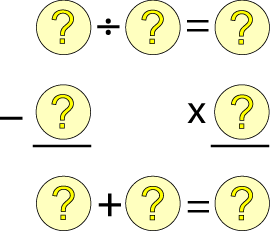A Square of Numbers Puzzle
 Can you put the numbers 1 to 8 (each number once and only once) into the circles so that the four calculations are correct?
Can you put the numbers 1 to 8 (each number once and only once) into the circles so that the four calculations are correct?
This problem is adapted from the NRICH task A Square of Numbers with permission of the University of Cambridge. All rights reserved.
13 Responses to A Square of Numbers Puzzle
Leave a Reply Cancel reply
You must be logged in to post a comment.
South Africa COVID-19 News
Here is the official website for COVID-19 updates.
Login
SUPPORT AIMSSEC






Use only the digits 1, 2, 3, 4, 5, 6, 7 and 8 – each digit once and only once.
Get your learners to solve the problem and let us know how they get on. What did they learn from the activity? What did you learn about their ability to learn?
I gave this to Grade 5 and Grade 7. Other learners did not use all the 8 numbers and I asked them to keep on trying. Others gave me two different correct results.
They enjoyed this.
You could follow up on this by asking the two learners who got correct results to explain how they went about solving the puzzle.This may give the rest of the learners some ideas on how to tackle the problem.They could then go on and try and find different solutions using some of the strategies you have discussed.
Very good activity,very challenging over a period of 30min ,i have given it over the weekend to do their options,i will come up with their result nextweek.
Remember to use the results as a platform for discussion on how the learners systematically went about solving the puzzle.Its these problem solving strategies that we are trying to teach the learners. It takes time and practise for the learners to feel confident with problem solving.
I gave my learners a clue that they must first use the big number because we are to reduce it by division ,then they tried this way 8 divide by 4 =2 & 8-7 =1+5=6 & 2 multiply by3= 6 , they got .I was very happy when I got 5 of them mastered the sum I asked them to help others
It was a fun of me when two learners came to me and said: ‘sorry teacher will you please give a classwork in this interesting sums.’ I asked which ones are those. They meant this problem.
I asked my learners to explaine how they got to the puzzle, they said they saw that in the division and mutiplication they can only take and use 6 or 8. If they have used 8 as a product they will take 6 as a dividend.
Do keep on trying as this will make your learners feel more comfortable with the idea of solving problems. As Elizabeth mentioned it is a good idea to get learners who found a solution to explain what and how they solved the problem, with the emphasis on the HOW.
This activity is interesting and my leaners will work individually.I will use scattered numbers from 1-8 and ask them to do it as a game.then those that have it right will stand on one side.They will then mix with those who did not get it and do it together.Again they will start again and do it in groups where the fastest will be the winners.I think this will help them in addition, multiplication, as well as in addition
The activity would be a great way of consolidating basic maths operations in intermediate phase.There are also many ways to adapt it to suit different grades like using flashcards and invent your own numbers to suit the level of the learners.
I like the idea that many people have suggested to put the numbers on small pieces of paper so that the learners can move them around. It often seems that if a learner has to write in pen or pencil they become afraid of making a mistake – even if it can be easily erased. By having numbers on cards or bits of paper that can easily be moved around learners will often try many more solutions and not be afraid of making mistakes.
Have you had a go with your learners? Please tell the other teachers what you have done and what happened with the learners. After reflecting, what would you do differently? What worked well? What could be improved? Were any BRILLIANT mistakes made that we could all learn from?